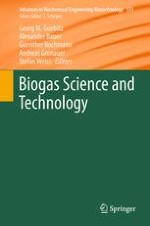2015 | OriginalPaper | Chapter
Hygiene and Sanitation in Biogas Plants
Authors : Bianca Fröschle, Monika Heiermann, Michael Lebuhn, Ute Messelhäusser, Matthias Plöchl
Published in: Biogas Science and Technology
Publisher: Springer International Publishing
Activate our intelligent search to find suitable subject content or patents.
Select sections of text to find matching patents with Artificial Intelligence. powered by
Select sections of text to find additional relevant content using AI-assisted search. powered by
